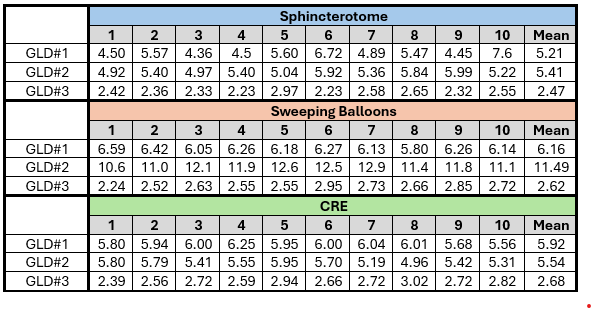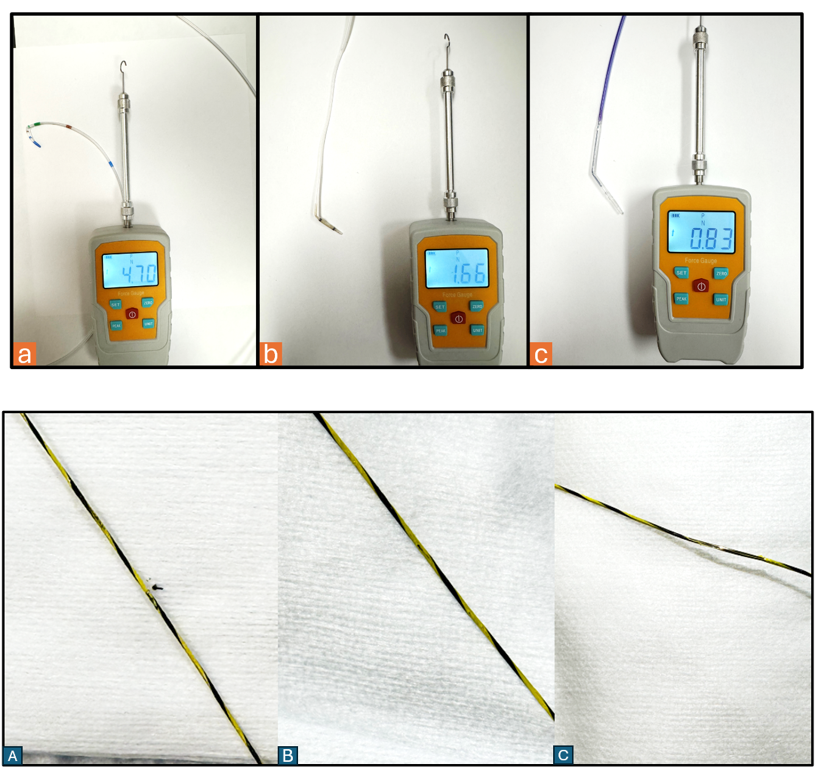Sunday Poster Session
Category: Interventional Endoscopy
P1376 - Currently Available Guidewire Locking Device (GLD) Designs in the Market Can Deform Expensive Endoscopic Retrograde Cholangiopancreatography (ERCP) Accessories and Compromise the Integrity of Guidewires
Sunday, October 26, 2025
3:30 PM - 7:00 PM PDT
Location: Exhibit Hall

Rashid Abdel-Razeq, MD
Cleveland Clinic Foundation
Cleveland, OH
Presenting Author(s)
Rashid Abdel-Razeq, MD1, Amit Bhatt, MD1, Hassan Siddiki, MD, MS, MEd2
1Cleveland Clinic Foundation, Cleveland, OH; 2Cleveland Clinic, Cleveland, OH
Introduction: GLDs used in ERCP secure guidewires and prevent fluid reflux through the biopsy channel. However, their internal design may create resistance during accessory insertion, and overly tight seals can deform devices, impacting procedural success. Repeated locking–unlocking cycles, especially in the presence of bile and contrast, may compromise the polytetrafluoroethylene (PTFE) coating on guidewires. This study aimed to evaluate the impact of current GLD designs on ERCP accessory integrity and guidewire durability.
Methods: Three commercial GLDs were tested using a validated Newton gauge. We measured the force required to permanently deform three ERCP accessories—sphincterotome, stone-extraction balloon, and dilating balloon—and the insertion force for each (10 insertions/accessory/GLD). PTFE integrity of guidewires exposed to bile and contrast was evaluated after ≥15 lock–unlock cycles. Damage was categorized as holes, fraying, or linear fractures, and scored 1–3 (1 = none, 3 = severe). ANOVA was used for comparisons. Deformation was also assessed as a binary variable (above vs. below threshold), with odds ratios calculated.
Results: The force required to permanently deform the sphincterotome was 4.70 N, stone-extraction balloon 1.60 N, and dilating balloon 0.88 N. Insertion forces differed significantly across GLDs for each accessory. For sphincterotomes, mean forces were: GLD#1 = 5.21 ± 0.94 N, GLD#2 = 5.41 ± 0.35 N, and GLD#3 = 2.47 ± 0.22 N (F = 62.1, p < 0.001); only GLD#3 did not cause deformation.
For stone-extraction balloons: GLD#1 = 6.16 ± 0.22 N, GLD#2 = 11.49 ± 0.72 N, GLD#3 = 2.62 ± 0.25 N (F = 970.3, p < 0.001); again, only GLD#3 remained below the deformation threshold. For CRE balloons: GLD#1 = 5.92 ± 0.20 N, GLD#2 = 5.54 ± 0.30 N, GLD#3 = 2.68 ± 0.20 N; however, all three exceeded the deformation threshold.
When analyzed as a binary outcome, GLD#3 had zero deformation events in sphincterotome and stone balloon testing, while GLD#1 and GLD#2 had 100%, yielding significant odds ratios favoring GLD#3 (p < 0.005 for all comparisons).
PTFE integrity analysis showed severe damage with GLD#2 (score: 8/9; holes and fractures), moderate with GLD#1 (5/9), and mild with GLD#3 (3/9).
Discussion: GLD designs vary in insertion resistance, with some exceeding deformation thresholds for ERCP devices. Repeated lock–unlock cycles, particularly with bile and contrast, can damage guidewire PTFE coating. Design refinements are needed to minimize device damage, cost, and risk.

Figure: Table 1: Insertional Force (Newtons) Across Locking Devices for Common ERCP Accessories

Figure: Figure 1: Representative images demonstrating the threshold force at which visible deformation occurred for each ERCP accessory using a Newton force gauge. (a) Sphincterotome deformation at 4.70 N, (b) Sweeping balloon deformation at 1.66 N, (c) CRE balloon deformation at 0.83 N
Figure 2: Visual comparison of GLD design effect on PTFE integrity. (A) Holes (B) Linear fractures (C) Fraying
Disclosures:
Rashid Abdel-Razeq indicated no relevant financial relationships.
Amit Bhatt indicated no relevant financial relationships.
Hassan Siddiki: Boston Scientific – Consultant. Steris – Consultant.
Rashid Abdel-Razeq, MD1, Amit Bhatt, MD1, Hassan Siddiki, MD, MS, MEd2. P1376 - Currently Available Guidewire Locking Device (GLD) Designs in the Market Can Deform Expensive Endoscopic Retrograde Cholangiopancreatography (ERCP) Accessories and Compromise the Integrity of Guidewires, ACG 2025 Annual Scientific Meeting Abstracts. Phoenix, AZ: American College of Gastroenterology.
1Cleveland Clinic Foundation, Cleveland, OH; 2Cleveland Clinic, Cleveland, OH
Introduction: GLDs used in ERCP secure guidewires and prevent fluid reflux through the biopsy channel. However, their internal design may create resistance during accessory insertion, and overly tight seals can deform devices, impacting procedural success. Repeated locking–unlocking cycles, especially in the presence of bile and contrast, may compromise the polytetrafluoroethylene (PTFE) coating on guidewires. This study aimed to evaluate the impact of current GLD designs on ERCP accessory integrity and guidewire durability.
Methods: Three commercial GLDs were tested using a validated Newton gauge. We measured the force required to permanently deform three ERCP accessories—sphincterotome, stone-extraction balloon, and dilating balloon—and the insertion force for each (10 insertions/accessory/GLD). PTFE integrity of guidewires exposed to bile and contrast was evaluated after ≥15 lock–unlock cycles. Damage was categorized as holes, fraying, or linear fractures, and scored 1–3 (1 = none, 3 = severe). ANOVA was used for comparisons. Deformation was also assessed as a binary variable (above vs. below threshold), with odds ratios calculated.
Results: The force required to permanently deform the sphincterotome was 4.70 N, stone-extraction balloon 1.60 N, and dilating balloon 0.88 N. Insertion forces differed significantly across GLDs for each accessory. For sphincterotomes, mean forces were: GLD#1 = 5.21 ± 0.94 N, GLD#2 = 5.41 ± 0.35 N, and GLD#3 = 2.47 ± 0.22 N (F = 62.1, p < 0.001); only GLD#3 did not cause deformation.
For stone-extraction balloons: GLD#1 = 6.16 ± 0.22 N, GLD#2 = 11.49 ± 0.72 N, GLD#3 = 2.62 ± 0.25 N (F = 970.3, p < 0.001); again, only GLD#3 remained below the deformation threshold. For CRE balloons: GLD#1 = 5.92 ± 0.20 N, GLD#2 = 5.54 ± 0.30 N, GLD#3 = 2.68 ± 0.20 N; however, all three exceeded the deformation threshold.
When analyzed as a binary outcome, GLD#3 had zero deformation events in sphincterotome and stone balloon testing, while GLD#1 and GLD#2 had 100%, yielding significant odds ratios favoring GLD#3 (p < 0.005 for all comparisons).
PTFE integrity analysis showed severe damage with GLD#2 (score: 8/9; holes and fractures), moderate with GLD#1 (5/9), and mild with GLD#3 (3/9).
Discussion: GLD designs vary in insertion resistance, with some exceeding deformation thresholds for ERCP devices. Repeated lock–unlock cycles, particularly with bile and contrast, can damage guidewire PTFE coating. Design refinements are needed to minimize device damage, cost, and risk.

Figure: Table 1: Insertional Force (Newtons) Across Locking Devices for Common ERCP Accessories

Figure: Figure 1: Representative images demonstrating the threshold force at which visible deformation occurred for each ERCP accessory using a Newton force gauge. (a) Sphincterotome deformation at 4.70 N, (b) Sweeping balloon deformation at 1.66 N, (c) CRE balloon deformation at 0.83 N
Figure 2: Visual comparison of GLD design effect on PTFE integrity. (A) Holes (B) Linear fractures (C) Fraying
Disclosures:
Rashid Abdel-Razeq indicated no relevant financial relationships.
Amit Bhatt indicated no relevant financial relationships.
Hassan Siddiki: Boston Scientific – Consultant. Steris – Consultant.
Rashid Abdel-Razeq, MD1, Amit Bhatt, MD1, Hassan Siddiki, MD, MS, MEd2. P1376 - Currently Available Guidewire Locking Device (GLD) Designs in the Market Can Deform Expensive Endoscopic Retrograde Cholangiopancreatography (ERCP) Accessories and Compromise the Integrity of Guidewires, ACG 2025 Annual Scientific Meeting Abstracts. Phoenix, AZ: American College of Gastroenterology.

